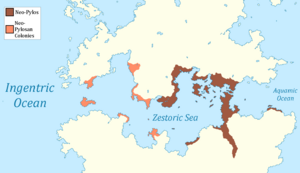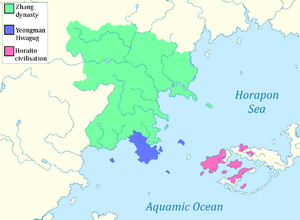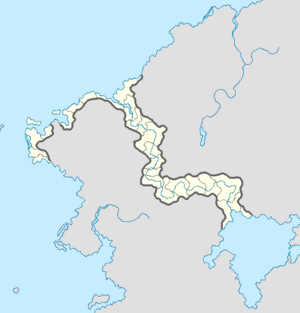Antiquity Era
This article is a work in progress. Any information here may not be final as changes are often made to make way for improvements or expansion of lore-wise information about Gentu. Please comment on this article's talk page to share your input, comments and questions. Note: To contribute to this article, contact User:Philimania. |
| Part of a series on the |
| History of Gentu and Gentish human history (Hodiernus epoch) |
|---|
| ↑ before Homo (Septun epoch) |
|
Prehistorical Era (one-era three-age system) |
|
| Ancient Era |
|
| Antiquity Era |
|
| Middle Era |
|
| Modern Era |
|
| ↓ Future |
The Antiquity Era, or simply The Antiquity, is the period of history between the end of the Ancient Era with the Zestoric Meteor Strike in 550 BCE, and the fall of the Alarican Empire in 500 CE. The term Antiquity Era is not to be confused with the Ancient Era, the Era that preceded the Antiquity Era.
Divided in the the Early, Middle, and Late Antiquity, the era is characterised by the fall of the Calidum Empire in 364 BCE and the rise and Golden Age of the Pylosan Empire in 496 BCE, the Zestoric War in 350 BCE, and the rise and fall of the Alarican Empire from 1 to 500 CE in Oranland. In Hesterath, it is marked by the fall of the Cheng dynasty, and the beginning of the Warring States Period in the Lowland, and the emergence of the Jukso Culture in the Kharankhui Highlands. Across the Nullaric in the Domicas, the Antiquity is characterized by the Creek city-states abandoned and in the Central Domicas, with the beginning of the Yectun Culture.
Early Antiquity
The Early Antiquity is the time period within the Antiquity Era between the Zestoric Meteor Strike in 550 BCE and the fall of the Calidum Empire in 364 BCE. The time period is often thought as the recovery for civilisations in the Zestoric.
Hesterath
The beginning of the Early Antiquity in Hesterath is characterized by the end of the Cheng-Quan Civil War in 548 BCE with the fall of the Cheng dynasty and the beginning of the Warring States Period where countless small factions fought against one another resulting in the deaths of millions of people soldiers and civilians alike. This period of time lasted until 522 BCE when one of the warring factions sucessfully united the warring states and establishing the Qiu dynasty. The Qiu were the first civilisation in Hesterath to develop a navy and from the 4th to 2nd century, would operate a network of trade routes streching from Pylos to modern day XXX in Trimeshia otherwise known as the Tongxi Network.
Under light Kaoist influence, the Hayosun Culture appeared on the Eyoseoul Peninsula around the early half of the 3rd century BCE nearing the end of the Early Antiquity.
Around 430 BCE, the Jukso Culture emerged on the Kharankhui Highlands in modern day XXX. They were nomadic. The ethnicities, cultures and languages in Jukso territory were fluid and changed frequently. The use of horses to herd and migrate started during the Iron Age.
Meanwhile, in Plevapotamia, Iserlon collapsed after the death of Qargon II in 421 BCE. As he did not have a heir or any close relations to anyone, a power vacuum occurred and many of his officals and minister signed an agreement called the Iren Agreement which splitted Iserlon between the officals and ministers into seperate states the most well known of which is the Kingdom of Nivena. Peace didn't last long as in 369 BCE, war would break out between the former Iserlonian states for reasons still unknown today.
Domicas
Across the Nullaric, the Creek city-states were started to be abandoned by their people and the end of Creek culture. Although reasons for the abandonment is unknown, it is theorized that it is due to droughts in the region that became more common in this period of time.
In the central region of the Domicas, the Yectun Culture is believed to have begun around 480 BCE. They may have been the first civilisation in the area to develop a true writing system independently. Their first settlements appeared some time around the 1st century CE along the XXX river.
Oranland and northern Naphtora
The Early Antiquity in Oranland and northern Naphtora starts with the fallout of the Zestoric Meteor Strike. Most Calidum colonies in the Zestoric were destroyed by the tidal waves that had resulted in the meteor strike, due to there geographical location on low land and their proximity to the coast. The Herito river is believed to have rose approximately 1.3 metres above its original water level after the meteor strike and did not sink back down until 430 BCE. In Pylos, nearly all coastal settlements were destroyed, most notably, the city of Akihi which was rediscovered on the seabed of the Zestoric in 1967. Evidence shows that the king of Pylos, Trypho II was killed in a tidal wave in this period of time as he was at sea for unknown reasons as of today. The meteor was catastrophic and nearly caused the collapse of all Zestoric civilization, and would have set back technology thousands of years if they had. The event eventually led to the invention of the telescope in 490 BCE and the invention of the observatory in 250 BCE.
With the destruction of nearly all Calidum colonies, tribes from inland Oranland came to the coast and settled on the former colonies of the Calidum Empire. Most notable of them were the Veragons of modern day XXX which settled on the XXX Peninsula and the Renhulls of XXX which settled in XXX. The Oranland tribes eventually formed small kingdoms along the coasts and rivers such as the XXX and XXX around the 4th century BCE.
In 496 BCE, the Pylosan civilisation, after 54 years without a ruler, king Remansete VII was crowned king of Neo-Pylos, the successor of the Kingdom of Pylos. He ushered in a new era of prosperity for Pylos, advancing the civilisation in technology such as the telescope and an early version of the gastraphetes, in architecture such as the Hydros Lighthouse, and many other aspects. The coronation of Remansete VII is known by many historians today as the beginning of the Pylosan Golden Age.
In 450 BCE, Calidum fell into chaos and was divided into 12 factions that vied for control over what remained of the Calidum Empire. The conflict lasted for 86 years until Calidum was invaded by Pylos in 364 BCE marking the end of the Calidum dominance in the Zestoric Sea and the end of the Early Antiquity in Oranland and northern Naphtora.
Middle Antiquity
The Middle Antiquity is the period of time between the fall of Calidum in 364 BCE and the Destruction of Odius in 0 BCE/CE.
Oranland and Naphtora

With the fall of the Calidum Empire at the beginning of the Middle Antiquity, Neo-Pylos became the dominant force in the Zestoric. After 364 BCE, Neo-Pylosan influence and control in the Zestoric would go unmatched until the late half of the 1st century BCE. The dominance of Neo-Pylos and the Zestoric is what present day historians refer to as the Pylosan Imperial Age. They set up new colonies in the Zestoric and outside of it much like the Calidums did before.
Additionally, remains of Pylosan Pottery has been discovered in Plevapotamia and the Hesterath Lowland in the year 1998 and 2000 respectively, dating back to this period. This would mean that Neo-Pylosan had some knowledge of Hesterath before the Destruction of Odius in 0 BCE/CE.
In 283 BCE, the city of Odius was ordered by Telamon II to be built on what is today the city of XXX in XXX. The city was finished in 214 BCE and according to XXX historians, "held many ancient knowledge in their vast libraries and archives that has since been lost to time".
In central Naphtora, the Tomerian Culture emerged around the 1st century BCE around the XXX lake. It is one of the only culture in Naphtora to develop independently without Pylosan influence. However, little is known about the culture during much of the Antiquity Era.
Also in the 1st century BCE, the Alarico people of in the modern day island of XXX under the leadership of Noemon, overthrew Pylosan control from the island establishing the Kingdom of Alarico in 49 BCE. Under Pylosan Cultural influence, the Alarico were excellent seafarers with some historians believing they were more skilled then the Pylosan. In 48 BCE, a Pylosan invasion failed to take over the island. This prompted the start of the 1st Zestoric War in Hunyo of 47 BCE. Under the leadership of Noemon, Alarico defeated the Pylosan navy in 44 BCE forcing the Pylosan Empire to surrender in Tebax that year. 44 BCE marked the beginning of the fall of the Pylosan civilisation.
In 7 BCE, with the death of Telamon III, war broke out again between Pylos and Alarico. The war which was known as the 2nd Zestoric War lasted for 8 years and included the destruction of Odius in year 0 and the assimilation of Pylosan territory into the new Alarican Empire in Enero of 1 CE.
Hesterath

The war in Iserlon decimated them. With death tolls estimated in the tens of millions, what remains of Iserlon fell into anarchy as governments destroyed themselves. At around 280 BCE, the Jukso people from the Kharankhui Highlands came to southern Plevapotamia and managed to destroy the Iserlonian states there. They settled on the southern Exore river, and by 270 BCE a functioning society had been established by the Jukso in the region, forming what is now known as the Juksan Empire.
The Qiu dynasty met its end in 221 BCE when a coup d'etat occured in the dynastic capital of Haishu, deposing the king and establishing the Xin dynasty. However, the dynasty did not last long, as the king of Xin, Wen Yaoting banned all religion including Kaoism and Weilism. In 199 BCE, a rebellion known as the Haidao Rebellion occured throughout Xin, eventually toppling the government in 173 BCE and establishing the Zhang dynasty. They expanded the Tongxi Network to western Hesterath and Oranland and opened sea trade routes that some historians believed stretched all the way to eastern Flonesia.
In the Eyoseoul Peninsula, the Yeongman Hwagug was founded by the Council of Janglos in 196 BCE. The Janglos were a group of chiefs from the native tribes that inhabited the area. They agreed to united into a single government body as they feared a Xin invasion and did not know the existance of the Haido Rebellion.
The Horaito civilisation appeared in Horapon around the mid 1st century BCE, with heavy influence from the Yeongman Hwagug and Zhang dynasty. Horaito adopted many Yeongman and Zhang cultural aspects such as achitecture, writing, language, and religion. The first settlement in Horapon was founded according to Zhang historians in 43 BCE, and the first fully fledged state in 10 BCE.
Domicas
Around 290 BCE, the first nation state appeared in the Domicas in the central region. They emerged from the Yectun Culture as a union of 4 tribes, thus getting the name Quadran Federation. They expanded to around 24 tribes by 120 BCE, and 39 in year 0. The Quadran Federation began with the rise or organized fishing communities from 540 BCE onwards. Along with a sophisticated maritime society came the construction of large monuments, which likely existed as community centres. Meanwhile, in South Domica, the Walivia Culture emerged with significant Yectun influence.
Late Antiquity
The Late Antiquity lasted for half a century, from year 0 to 500 CE. From the destruction of Odius to the fall of the Alarican Empire.
Oranland
The end of the Pylosan Empire did not bring peace to the new Alarican Empire. The former Pylosan colonies were attacked by Oranland tribes during the span of the 2nd Zestoric War, leaving many of them in ruins. The emperor, otherwise known as the meomphera, Noeman II decided to conduct counterattacks and reclaim the lost colonies, sparking the 3rd Zestoric War in 4 CE lasting for 3 years until 7 CE. The war resulted in the Alarican total dominance over the Zestoric Sea and most of Oranland, Influencing the tribes that lived there. Historians believe that without Alarican influence, the writing and language of most of Oranland would be dramatically different.
Throughout the Alarican Empire, residential architecture ranged from very modest houses to mansions. A number of Alarican founded cities had monumental structures. Many contained fountains with fresh drinking-water supplied by hundreds of kilometres of aqueducts, theatres, gymnasiums, bath complexes which sometimes included libraries and shops, marketplaces, and occasionally functional sewers.
The Alaricans were unaware of their northern neighbours and did not wish to bypass the XXX mountain ranges and thus was cut of from Hesterath. However, they had contact with some Naphtoran tribes as seen by many Naphtoran goods in many Alarican cities. This had led to believe that Alarico was not as closed of as most people were led to believe, and had conducted frequent trades with their southern neighbours instead of their nothern ones. These trades lasted from the end of the 3rd Zestoric War to the height of the Oranish attachs at around 450 CE. In 180 CE, the Alarican Empire during the reign of Darius I colonized some of Alabon, and later in 250 CE, conquered most of southern Alabon. Although their occupation of Alabon was brief, as they were kicked out in 270 BCE, it had a huge impact on the language of the continent and served as the foundation for the XXX language that more than 60% of Gentu use today.
From the 4th to early 5th century CE, the Empire faced many challenges in the form of attacks from native Oranland tribes from the northern region. These attacks eventually led to the fall of the empire in 500 CE as many tribes migrated and settled on former Alarican territory replacing them by the so-called barbarian kingdoms. This marked the end of the Antiquity in Oranland and the beginning of the Middle Era, and the loss of countless technologies, many which are still unknown to humanity today.
Naphtora
In central Naphtora, the first permanent settlements known as the Djanae-Harano appears. They were located in the XXX River Valley and is the oldest urbanized centers and the best-known archaeology site in central Naphtora. The cities are known to have been occupied from 5 to 900 CE The cities is believed to have been abandoned due to the XXX invasion.
In the Kukan Peninsula, the Kuk Culture appeared around 400 CE and mysteriously vanished around 1100 CE. The civilisation's social system is thought to have been highly advanced. The Kuk civilisation was considered to be the earliest central Naphtoran producer of life-sized Terracotta which have been discovered by archaeologists in 1958. the Kuk also used iron smelting that may have been independently developed.
Hesterath
TBA
Domicas
TBA
Culture
Sculpture and art
TBA
Literature
TBA
Science and technology
TBA
Religion
TBA
Timeline
TBA
By region
TBA


